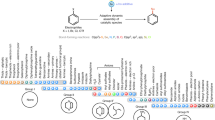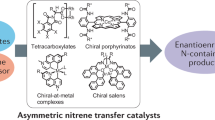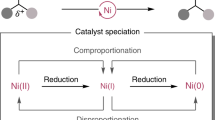Abstract
Numerous important transition metal-catalysed reactions rely on stoichiometric quantities of an exogenous base to enable catalytic turnover. Despite playing a fundamental role, the base poses major challenges, such as restricting the accessible chemical space or causing heterogeneous reaction mixtures. Here we introduce a unifying strategy that eliminates the need for an exogenous base through the use of non-innocent electrophiles (NIE), which are equipped with a masked base that is released in a controlled fashion during the reaction. The universal applicability of this concept was demonstrated by turning multiple, traditionally base-dependent, catalytic reactions into exogenous base-free homogeneous processes. Furthermore, the advantageous features of NIEs were demonstrated in multiple applications, such as in a micromole-scale fluorescence-based assay. This led to the discovery of a Ni-catalysed deoxygenation reaction of aryl carbamates using isopropanol as a benign reductant. In a broader context, this work provides a conceptual blueprint for the strategic utilization of NIEs in catalysis.

This is a preview of subscription content, access via your institution
Access options
Access Nature and 54 other Nature Portfolio journals
Get Nature+, our best-value online-access subscription
$29.99 / 30 days
cancel any time
Subscribe to this journal
Receive 12 digital issues and online access to articles
$119.00 per year
only $9.92 per issue
Buy this article
- Purchase on Springer Link
- Instant access to full article PDF
Prices may be subject to local taxes which are calculated during checkout






Similar content being viewed by others
Data availability
The data that support the findings of this study are available within the article and its Supplementary Information. All data are available from the authors upon reasonable request. Crystallographic data for compounds 22 and 30 were deposited on the Cambridge Structural Database and are freely available via the Cambridge Crystallographic Data Centre under CCDC numbers 2070177 and 2070176.
References
Diederich, F. & Stang, P. (eds) Metal-Catalyzed Cross-Coupling Reactions (Wiley, 2008).
Suzuki, A. Cross-coupling reactions of organoboranes: an easy way to construct C-C bonds (Nobel Lecture). Angew. Chem. Int. Ed. Engl. 50, 6722–6737 (2011).
Wu, X.-F., Anbarasan, P., Neumann, H. & Beller, M. From noble metal to Nobel Prize: palladium-catalyzed coupling reactions as key methods in organic synthesis. Angew. Chem. Int. Ed. Engl. 49, 9047–9050 (2010).
Magano, J. & Dunetz, J. R. Large-scale applications of transition metal-catalyzed couplings for the synthesis of pharmaceuticals. Chem. Rev. 111, 2177–2250 (2011).
Ruiz-Castillo, P. & Buchwald, S. L. Applications of palladium-catalyzed C−N cross-coupling reactions. Chem. Rev. 116, 12564–12649 (2016).
Meyers, C. et al. Study of a new rate increasing "base effect" in the palladium-catalyzed amination of aryl iodides. J. Org. Chem. 69, 6010–6017 (2004).
Kuethe, J. T., Childers, K. G., Humphrey, G. R., Journet, M. & Peng, Z. A rapid, large-scale synthesis of a potent cholecystokinin (CCK) 1R receptor agonist. Org. Process Res. Dev. 12, 1201–1208 (2008).
Kashani, S. K., Jessiman, J. E. & Newman, S. G. Exploring homogeneous conditions for mild Buchwald-Hartwig amination in batch and flow. Org. Process Res. Dev. 24, 1948–1954 (2020).
Buitrago Santanilla, A. et al. Nanomole-scale high-throughput chemistry for the synthesis of complex molecules. Science 347, 49–53 (2015).
Brusoe, A. T. & Hartwig, J. F. Palladium-catalyzed arylation of fluoroalkylamines. J. Am. Chem. Soc. 137, 8460–8468 (2015).
Cox, P. A. et al. Base-catalyzed aryl-B(OH)2 protodeboronation revisited: from concerted proton transfer to liberation of a transient aryl anion. J. Am. Chem. Soc. 139, 13156–13165 (2017).
Dennis, J. M., White, N. A., Liu, R. Y. & Buchwald, S. L. Breaking the base barrier: an electron-deficient palladium catalyst enables the use of a common soluble base in C–N coupling. J. Am. Chem. Soc. 140, 4721–4725 (2018).
Liu, R. Y., Dennis, J. M. & Buchwald, S. L. The quest for the ideal base: rational design of a nickel precatalyst enables mild, homogeneous C−N cross-coupling. J. Am. Chem. Soc. 142, 4500–4507 (2020).
Prashad, M. et al. β-hydrogen-containing sodium alkoxides as suitable bases in palladium-catalyzed aminations of aryl halides. J. Org. Chem. 65, 2612–2614 (2000).
Trost, B. M. The atom economy–a search for synthetic efficiency. Science 254, 1471–1477 (1991).
Sheldon, R. A. Atom efficiency and catalysis in organic synthesis. Pure Appl. Chem. 72, 1233–1246 (2000).
Anastas, P. T., Kirchhoff, M. M. & Williamson, T. C. Catalysis as a foundational pillar of green chemistry. Appl. Catal. A Gen. 221, 3–13 (2001).
Roglans, A., Pla-Quintana, A. & Moreno-Mañas, M. Diazonium salts as substrates in palladium-catalyzed cross-coupling reactions. Chem. Rev. 106, 4622–4643 (2006).
Chen, L., Sanchez, D. R., Zhang, B. & Carrow, B. P. “Cationic“ Suzuki–Miyaura coupling with acutely base-sensitive boronic acids. J. Am. Chem. Soc. 139, 12418–12421 (2017).
Ohashi, M., Saijo, H., Shibata, M. & Ogochi, S. Palladium-catalyzed base-free Suzuki–Miyaura coupling reactions of fluorinated alkenes and arenes via a palladium fluoride key intermediate. Eur. J. Org. Chem. 443–447 (2013).
Wang, Y., Wu, S.-B., Shi, W.-J. & Shi, Z.-J. C‒O/C‒H coupling of polyfluoroarenes with aryl carbamates by cooperative Ni/Cu catalysis. Org. Lett. 18, 2548–2551 (2016).
Stephan, M. S., Teunissen, A. J. J. M., Verzijl, G. K. M. & de Vries, J. G. Heck reactions without salt formation: aromatic carboxylic anhydrides as arylating agents. Angew. Chem. Int. Ed. 37, 662–664 (1998).
Malapit, C. A., Bour, J. R., Brigham, C. E. & Sanford, M. S. Base-free nickel-catalysed decarbonylative Suzuki–Miyaura coupling of acid fluorides. Nature 563, 100–104 (2018).
Kakiuchi, F., Usui, M., Ueno, S., Chatani, N. & Murai, S. Ruthenium-catalyzed functionalization of aryl carbon–oxygen bonds in aromatic ethers with organoboron compounds. J. Am. Chem. Soc. 126, 2706–2707 (2004).
Zhao, Y. & Snieckus, V. Ester-directed Ru-catalyzed C–O activation/C–C coupling reaction of ortho-methoxy naphthoates with organoboroneopentylates. Chem. Commun. 52, 1681–1684 (2016).
Nishizawa, A. et al. Nickel-catalyzed decarboxylation of aryl carbamates for converting phenols into aromatic amines. J. Am. Chem. Soc. 141, 7261–7265 (2019).
Zarate, C., van Gemmeren, M., Somerville, R. J. & Martin, R. Chapter Four – phenol derivatives: modern electrophiles in cross-coupling reactions. Adv. Organomet. Chem. 66, 143–222 (2016).
Atkins, K. E., Walker, W. E. & Manyik, R. M. Palladium catalyzed transfer of allylic groups. Tetrahedron Lett. 11, 3821–3824 (1970).
Trost, B. M. & Molander, G. A. Neutral alkylations via palladium(0) catalysis. J. Am. Chem. Soc. 103, 5969–5972 (1981).
Tsuji, J., Shimizu, I., Minami, I. & Ohashi, Y. Facile palladium catalyzed decarboxylative allylation of active methylene compounds under neutral conditions using allylic carbonates. Tetrahedron Lett. 23, 4809–4812 (1982).
Shimasaki, T., Tobisu, M. & Chatani, N. Nickel-catalyzed amination of aryl pivalates by the cleavage of aryl C−O bonds. Angew. Chem. Int. Ed. 49, 2929–2932 (2010).
Mesganaw, T. et al. Nickel-catalyzed amination of aryl carbamates and sequential site-selective cross-couplings. Chem. Sci. 2, 1766–1771 (2011).
Ehle, A. R., Zhou, Q. & Watson, M. P. Nickel(0)-Catalyzed Heck Cross-Coupling via Activation of Aryl C−OPiv Bonds. Org. Lett. 14, 1202–1205 (2012).
Quasdorf, K. W., Riener, M., Petrova, K. V. & Garg, N. K. Suzuki−Miyaura coupling of aryl carbamates, carbonates, and sulfamates. J. Am. Chem. Soc. 131, 17748–17749 (2009).
Antoft-Finch, A., Blackburn, T. & Snieckus, V. N,N-Diethyl O-carbamate: directed metalation group and orthogonal Suzuki–Miyaura cross-coupling partner. J. Am. Chem. Soc. 131, 17750–17752 (2009).
Takise, R., Muto, K., Yamaguchi, J. & Itami, K. Nickel-catalyzed α-arylation of ketones with phenol derivatives. Angew. Chem. Int. Ed. 53, 6791–6794 (2014).
Harada, T., Ueda, Y., Iwai, T. & Sawamura, M. Nickel-catalyzed amination of aryl fluorides with primary amines. Chem. Commun. 54, 1718–1721 (2018).
Muto, K., Yamaguchi, J. & Itami, K. Nickel-catalyzed C−H/C−O coupling of azoles with phenol derivatives. J. Am. Chem. Soc. 134, 169–172 (2012).
Huang, K., Yu, D.-G., Zheng, S.-F., Wu, Z.-H. & Shi, Z.-J. Borylation of aryl and alkenyl carbamates through Ni-catalyzed C−O activation. Chem. Eur. J. 17, 786–791 (2011).
Takise, R., Itami, K. & Yamaguchi, J. Cyanation of phenol derivatives with aminoacetonitriles by nickel catalysis. Org. Lett. 18, 4428–4431 (2016).
Gu, Y. & Martín, R. Ni-catalyzed stannylation of aryl esters via C−O bond cleavage. Angew. Chem. Int. Ed. 56, 3187–3190 (2017).
Shevlin, M. Practical high-throughput experimentation for chemists. ACS Med. Chem. Lett. 8, 601–607 (2017).
Mennen, S. M. et al. The evolution of high-throughput experimentation in pharmaceutical development and perspectives on the future. Org. Process Res. Dev. 23, 1213–1242 (2019).
Schafer, W., Bu. X., Gong X., Joyce, L. A. & Welch, C. J. in Comprehensive Organic Synthesis II 2nd edn, Vol. 9 (eds Knochel. P. & Molander, G. A.) 28–53 (Elsevier, 2014).
Collins, K. D., Gensch, T. & Glorius, F. Contemporary screening approaches to reaction discovery and development. Nat. Chem. 6, 859–871 (2014).
Shaughnessy, K. H., Kim, P. & Hartwig, J. F. A fluorescence-based assay for high-throughput screening of coupling reactions. Application to Heck chemistry. J. Am. Chem. Soc. 121, 2123–2132 (1999).
Barder, T. E. & Buchwald, S. L. Benchtop monitoring of reaction progress via visual recognition with a handheld UV lamp: in situ monitoring of boronic acids in the Suzuki–Miyaura reaction. Org. Lett. 9, 137–139 (2007).
Mesganaw, T., Fine Nathel, N. F. & Garg, N. K. Cine substitution of arenes using the aryl carbamate as a removable directing group. Org. Lett. 14, 2918–2921 (2012).
Yasui, K., Higashino, M., Chatani, N. & Tobisu, M. Rhodium-catalyzed reductive cleavage of aryl carbamates using isopropanol as a reductant. Synlett 28, 2569–2572 (2017).
Yu, D.-G. & Shi, Z.-J. Mutual activation: Suzuki–Miyaura coupling through direct cleavage of the sp2 C−O bond of naphtholate. Angew. Chem. Int. Ed. 50, 7097–7100 (2011).
Acknowledgements
ETH Zurich is acknowledged for financial support. G.T. acknowledges the Studienstiftung des deutschen Volkes (German Academic Scholarship Foundation) for a predoctoral scholarship. We thank the NMR, MS (MoBiAS) and X-ray (SMoCC) technology platforms at ETH Zurich for technical assistance. H. Schmitt (ETH Zurich) is acknowledged for reproducing results. We thank J. W. Bode (ETH Zurich) for access to the fluorescence microplate reader and A. Schuhmacher (ETH Zurich) for instruction and technical assistance. The authors thank the Morandi group for discussion and proofreading of the manuscript.
Author information
Authors and Affiliations
Contributions
G.T. conceived the project. G.T. designed and performed the experimental studies. B.M. supervised the research. Both authors contributed to the writing and editing of the final manuscript.
Corresponding author
Ethics declarations
Competing interests
The authors declare no competing interests.
Peer review
Peer review information
Nature Catalysis thanks Michael Shevlin and the other, anonymous, reviewer(s) for their contribution to the peer review of this work.
Additional information
Publisher’s note Springer Nature remains neutral with regard to jurisdictional claims in published maps and institutional affiliations.
Supplementary information
Supplementary Information
Supplementary Methods, Figs. 1–16, Tables 1–31 and refs.
Supplementary Data 1
Crystallographic data of compound 30.
Supplementary Data 2
Crystallographic data of compound 22.
Rights and permissions
About this article
Cite this article
Toupalas, G., Morandi, B. Non-innocent electrophiles unlock exogenous base-free coupling reactions. Nat Catal 5, 324–331 (2022). https://doi.org/10.1038/s41929-022-00770-x
Received:
Accepted:
Published:
Issue Date:
DOI: https://doi.org/10.1038/s41929-022-00770-x
This article is cited by
-
Ni-catalyzed mild hydrogenolysis and oxidations of C–O bonds via carbonate redox tags
Nature Communications (2023)



